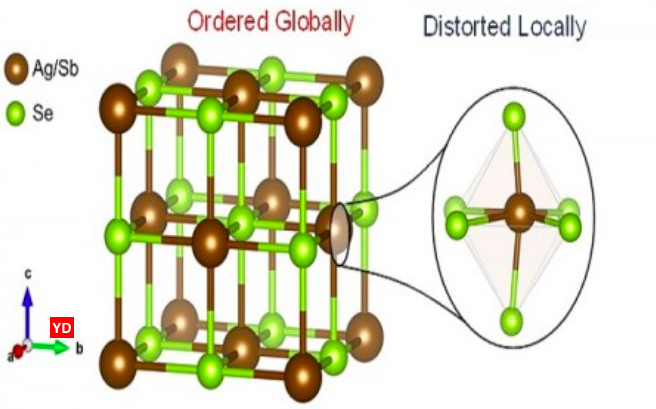Indian scientists have cracked the origin of ultralow thermal conductivity in silver antimony selenide (AgSbSe2), a crystalline solid having promising thermoelectric applications, an official statement said.
This work brings out the importance of investigating the local structure of a material to understand the origin of heat transport, one of the fundamental properties of matter, and having several applications, such as in semiconductor electronics, thermo-electrics, and thermal barrier coating.
They have found that the AgSbSe2 has a deformed local structure, which, while keeping the average structure intact, results in the ultra-low thermal conductivity.
As per the statement, in crystalline materials, where the atoms are arranged closely in a periodic and ordered fashion, heat mainly passes through conduction, as neighbouring atoms vibrate and transfer the heat. The rate at which heat can transfer from a hot end to a cold end is called thermal conductivity, and often the absolute value of this thermal conductivity dictates the applicability of a material in different industries.
“Materials with very high thermal conductivity are widely used as heat sinks in semiconductor electronics or as heat radiators, while ultra-low thermal conductive materials are useful in heat insulation applications of thermo-electrics. Therefore, studying and understanding the heat transport of materials are extremely important for both fundamental and practical points of view,” the Science and Technology Ministry statement said.
Professor Kanishka Biswas and his student Moinak Dutta from Jawaharlal Nehru Centre for Advanced Scientific Research (JNCASR), Bangalore, an autonomous institute of the Department of Science & Technology, in their recent paper published in ‘Angewandte Chemie’ have investigated the origin of ultralow thermal conductivity in AgSbSe2.
While crystalline materials are highly thermal conductive, AgSbSe2 defies the norm and exhibits thermal conductivity like amorphous materials like glass. To investigate such anomalies in heat transport, they probed the arrangement of atoms inside the locally coordinated environment of the crystal using a technique called synchrotron X-ray pair distribution function (PDF) analysis. Through the analysis, they observed that the so-called periodically ordered and crystalline AgSbSe2 is actually not so ordered in local scale. The antimony is found to be off-centered from its ideal position, resulting in the distortion of the otherwise perfect ordered arrangement. This breaks the symmetry locally, thus resulting in a low thermal conductivity.
Biswas said that the distortion of Sb is only restricted to a few angstroms, and there is an equal probability of distortion in six different positions, which are often in polar opposite directions. “So, when viewed for a large number of atoms, the six positions average out to look like that the Sb actually sits in its ideal position. Thus, such deformed local structure of AgSbSe2, while keeping the average structure intact, resulted in the ultra-low thermal conductivity,” he said.
The synchrotron X-ray PDF experiment performed under India-DESY (Deutsches Elektronen-Synchrotron) collaboration establishes that more often than not, most of the fundamental physical properties of materials can be traced to their local structure, which can only be understood if it is looked deeper into the atomic scale.


